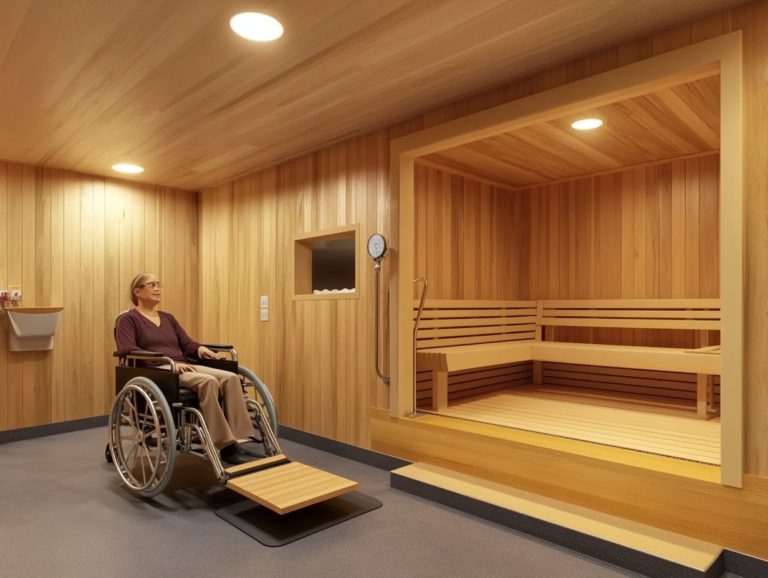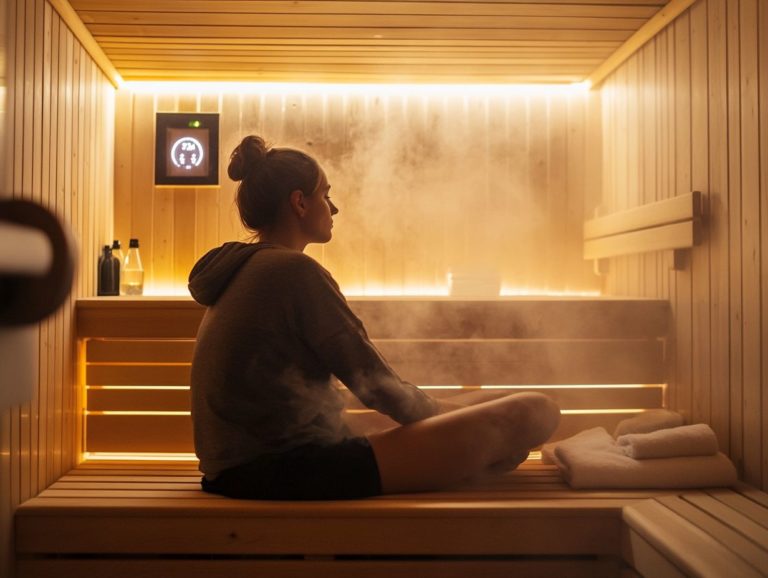Sauna Safety Measures for Group Activities
Saunas provide a remarkable fusion of relaxation and health benefits. It’s crucial to prioritize sauna safety, especially in group settings.
This article explores the different types of saunas and how they operate. We’ll also highlight potential risks associated with their use.
You ll discover essential precautions for group sauna sessions at fitness centers, including proper etiquette and safety measures for various age groups.
We also provide sauna tips to ensure you re well-prepared for a safe experience. This includes monitoring for emergencies and responding effectively.
Join us on this exciting journey to learn everything you need for a safe and enjoyable sauna experience.
Contents
- Key Takeaways:
- Understanding Sauna Safety
- Precautions for Group Sauna Activities
- Preparing for a Safe Sauna Experience
- Monitoring and Responding to Emergencies
- Frequently Asked Questions
- What are the recommended safety measures for group activities in a sauna?
- Can anyone participate in a sauna group activity?
- What are the benefits of having a sauna attendant present during group activities?
- How can we ensure proper ventilation in a sauna for group activities?
- What are some signs of overheating in a sauna?
- What should I do if there is an emergency during a sauna group activity?
Key Takeaways:
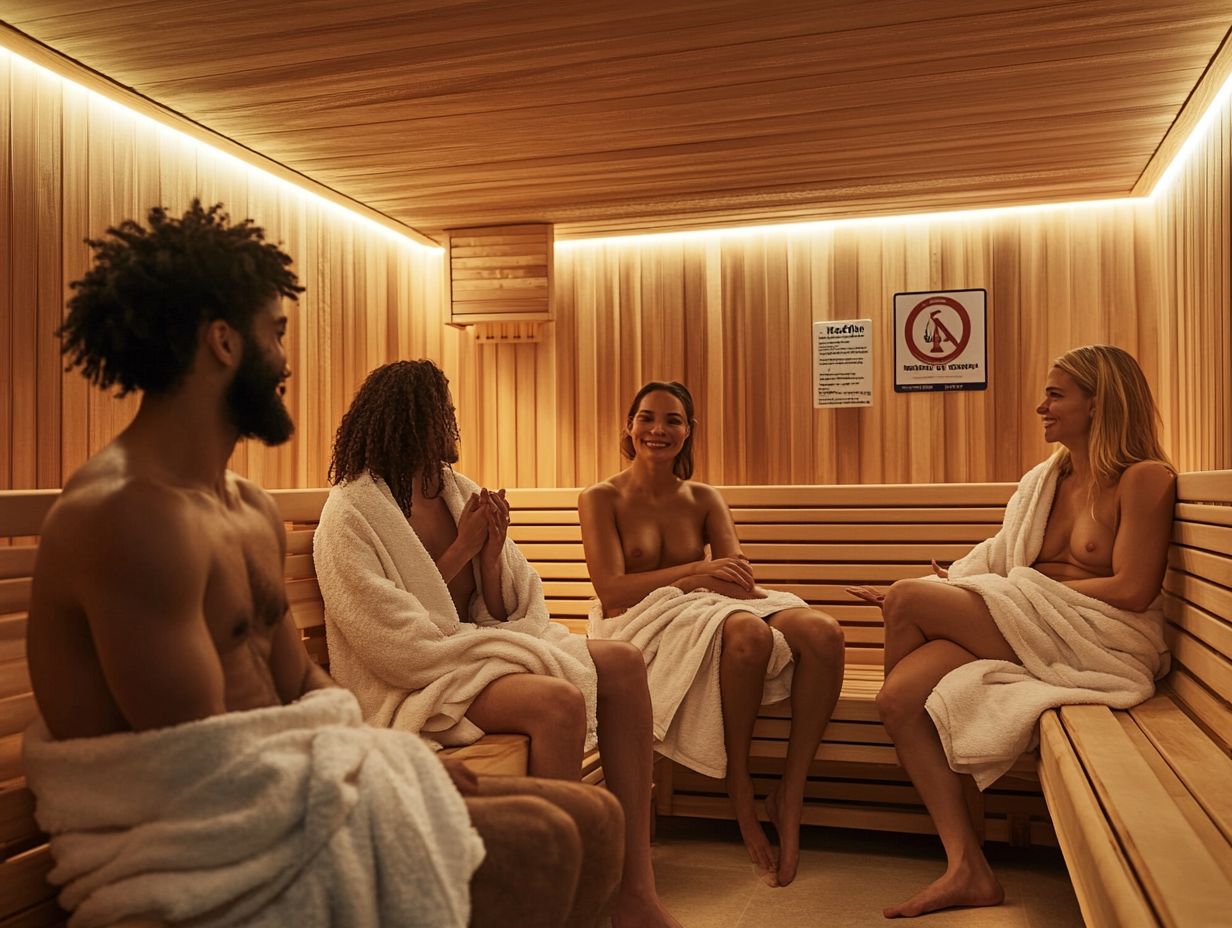
- Always follow proper etiquette and guidelines in group sauna activities to keep yourself and others safe.
- Drink plenty of water to stay hydrated before and during a sauna session, especially for older adults and children.
- Knowing the signs of overheating and not having enough water in your body, along with first aid procedures, can help you respond to emergencies during a sauna session.
Understanding Sauna Safety
Understanding sauna safety is crucial for fully harnessing the many health benefits of saunas, such as improved heart health, better joint mobility, and relief from muscle soreness.
As you explore different types of saunas, whether traditional wood-burning or modern infrared, remember to follow temperature guidelines and monitor your body temperature for a safe experience.
Prioritize supervision, especially for children and pregnant women. Adopt effective sauna tips and safety measures to minimize health risks.
What is a Sauna and How Does it Work?
A sauna is your personal retreat a small room or building designed to envelop you in dry heat that promotes relaxation and offers many health benefits. This experience is created using an electrical heater or a wood-burning stove, often with sauna stones that retain heat well.
Unlike a steam room, where humidity is high, saunas keep the humidity low, raising your body temperature and encouraging the soothing release of sweat.
When you enter a sauna, you’re greeted by comforting warmth that varies depending on the type of sauna. Traditional wood-burning saunas offer an authentic experience, with heated stones over a flame creating a cozy ambiance.
On the other hand, infrared saunas use light technology to provide gentler, more penetrating heat that warms your body directly rather than the surrounding air.
In this relaxing space, sauna stones are vital; they capture and radiate heat while enhancing the atmosphere when you pour water over them. Understanding these elements highlights the unique sensations and benefits saunas offer, distinguishing them from steam rooms, where moisture and heat combine for a different therapeutic experience.
Potential Risks and Dangers
While saunas offer numerous health benefits, be aware of potential risks, especially if safety precautions aren’t followed. High temperatures can lead to not having enough water in your body, overheating, and negative reactions, particularly for pregnant women or those under the influence of alcohol or drugs.
To ensure a safe sauna experience, stay hydrated before, during, and after your session. Drinking water helps offset fluid loss from sweating, minimizing the chances of heat-related illnesses. For more insights on staying safe, consider exploring sauna safety and the role of social support.
Cooling down gradually after exiting the sauna is important for your body to adjust back to normal temperatures. Specific groups, like those with heart conditions, breathing issues, or the elderly, should take extra caution and consider consulting healthcare professionals before using a sauna. It’s also essential to follow sauna safety protocols for group sessions to ensure a safe experience.
Stay alert for signs of overheating, such as dizziness or headaches, to protect yourself and fully enjoy the benefits of sauna therapy.
Practice the tips shared here and always prioritize safety for a fulfilling sauna experience!
Precautions for Group Sauna Activities
When participating in group sauna activities, it’s crucial to adhere to precautionary measures to ensure the safety and comfort of everyone involved, especially in a fitness or wellness center where multiple individuals share the same space.
Emphasizing proper hygiene practices, such as regular cleaning and a solid grasp of sauna etiquette, is essential. Implementing safety measures like safety locks for sauna doors plays a vital role in preventing accidents and making the sauna enjoyable for everyone. Additionally, understanding sauna safety helps in supporting each other during the experience.
Proper Etiquette and Guidelines
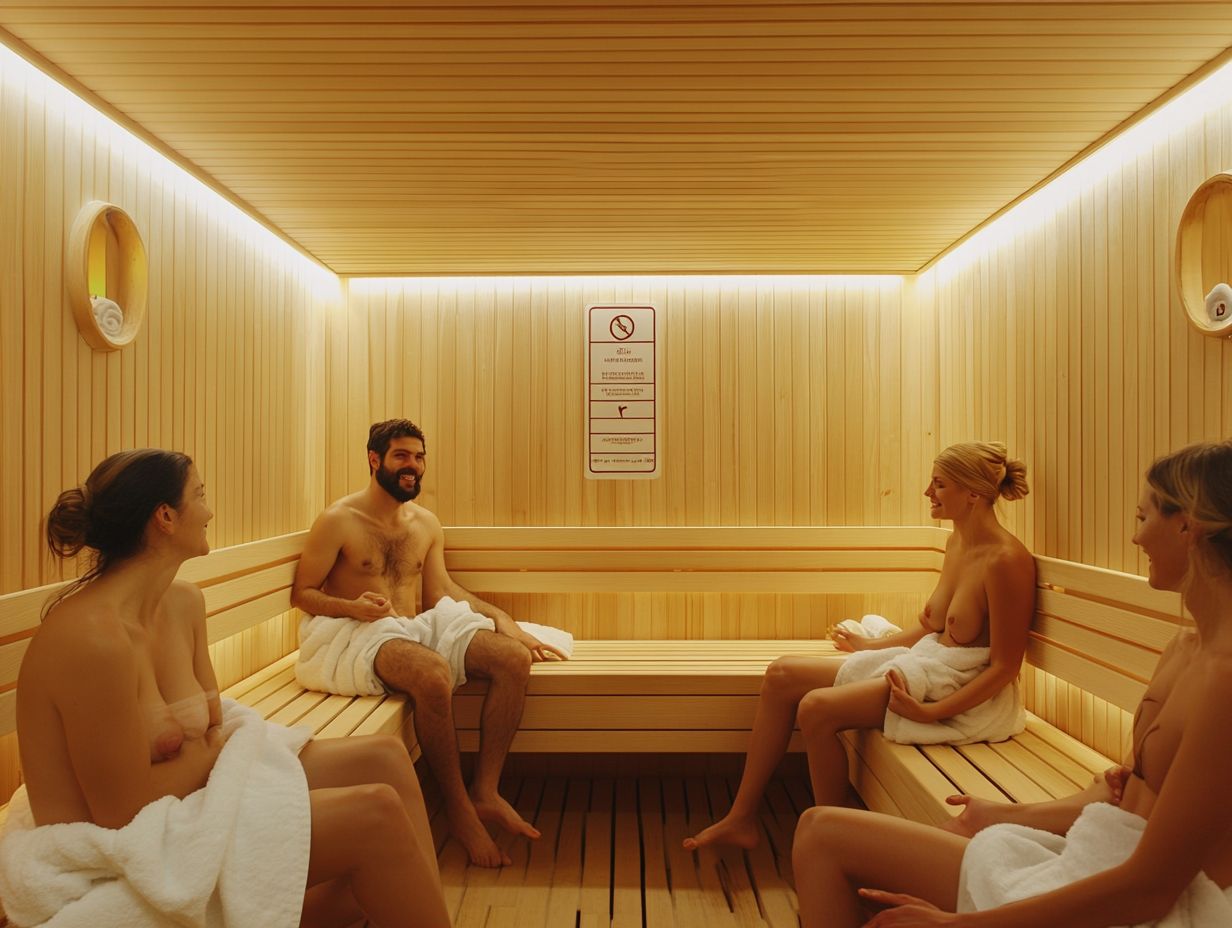
To elevate your sauna experience, embrace proper etiquette and guidelines. This includes showering before entry, keeping noise to a minimum, and respecting others’ personal space. These practices promote hygiene and foster a serene atmosphere, ensuring a safe and enjoyable environment.
Bringing a towel to sit on is highly advisable; it maintains cleanliness and adds comfort for all patrons. Limit excessive talking and refrain from using electronic devices to fully unwind and absorb the therapeutic benefits of the sauna.
Maintaining a respectful temperature during rituals, such as using essential oils, can enhance the experience. By adhering to these etiquette principles, you contribute significantly to a harmonious ambiance for all sauna-goers.
Safety Measures for Different Age Groups
Implementing tailored safety measures is essential when you step into a sauna, especially at a fitness facility or wellness center. Children and pregnant women require extra supervision and adjustments to temperature guidelines to ensure a safe experience. Know your health conditions to stay safe and enjoy your sauna time!
For example, children have a higher body temperature and may not handle heat as well as adults. Their sauna sessions should be shorter and set at lower heat levels to prevent overheating. It’s also important to consider sauna safety when engaging in active participation.
Pregnant women should always consult their healthcare providers before indulging in sauna time, as high temperatures can pose risks to fetal development. Be especially cautious if you have health conditions like cardiovascular disease or diabetes, as sauna use can sometimes worsen these conditions.
By customizing sauna experiences for these unique needs, you can enjoy the benefits of heat therapy, which uses warmth to relieve discomfort, while minimizing potential hazards.
Preparing for a Safe Sauna Experience
Preparing for a safe sauna experience requires attention to several key factors, including proper hydration, nutrition tips, and selecting the right attire to ensure comfort and safety.
Hydrate well to enjoy your sauna session to the fullest! Drinking plenty of water prevents dehydration during your sessions. Choosing appropriate clothing that promotes ease of movement and enhances comfort will elevate your overall experience.
Don t miss out on the benefits of heat therapy; make sure you follow these guidelines for a fantastic sauna experience!
Hydration and Nutrition Tips
Maintaining proper hydration and adhering to nutrition tips before, during, and after your sauna sessions are essential for both safety and the maximization of health benefits. It s advisable for you to consume water and electrolytes to replace fluids lost through sweating.
Steering clear of alcohol prior to your sauna visit will help ensure you remain optimally hydrated and feeling your best. Consider incorporating a variety of fluids like coconut water, herbal teas, or sports drinks to effectively replenish vital electrolytes such as sodium, potassium, and magnesium key parts that help keep your body balanced with fluids.
Enjoying nutrient-rich snacks, particularly fruits with high water content or those packed with healthy fats and proteins, can enhance your sauna experience by providing energy and supporting recovery. Staying proactive about hydration, especially in the heat of a sauna, promotes your overall well-being.
Make your sauna sessions a genuinely revitalizing retreat!
What to Wear and Bring
Choosing the right attire for your sauna experience is crucial for comfort and hygiene. This greatly influences how much you enjoy your sauna session.
Opt for lightweight materials that allow your skin to breathe, and don t forget to bring along a towel for seating this helps maintain hygiene, especially in shared sauna settings. Proper hygiene is very important.
Not only does it protect you from spreading bacteria, but it also enhances your overall relaxation. Fabrics like cotton or moisture-wicking blends are ideal, offering comfort and ease as the heat envelops you.
Make smart choices to transform your sauna experience! A strategically placed towel can act as a protective barrier, ensuring a more pleasant experience for everyone involved.
Layering with a robe can also make your transition back into everyday clothes feel seamless after your sauna session. Consider sauna types that best suit your personal preference to elevate your journey.
Monitoring and Responding to Emergencies
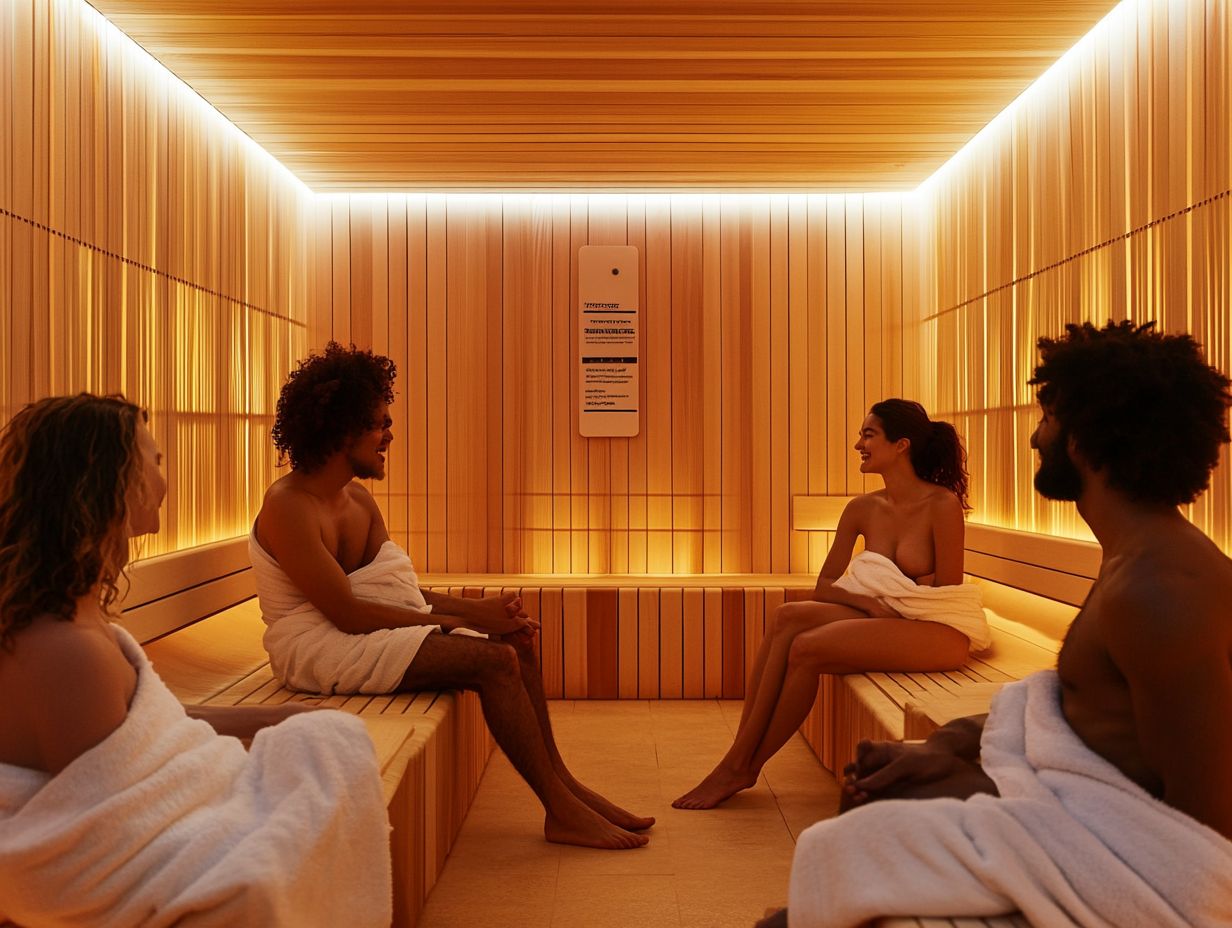
Monitoring and responding to emergencies while using a sauna is essential for ensuring safety and well-being, especially when you notice signs of overheating or dehydration in yourself or others.
Knowing sauna safety helps you avoid risks. Being informed about emergency procedures and having a foundational grasp of first aid can significantly impact your ability to address any health concerns that may arise during your sauna sessions, particularly for those with existing health conditions. Understanding sauna safety and peer pressure is also crucial for ensuring a safe experience.
Signs of Overheating and Dehydration
Recognizing the signs of overheating and dehydration is vital for maintaining sauna safety. This ensures a pleasurable experience for everyone involved, especially in a fitness center or wellness center setting.
Being attentive to your own body and the well-being of those around you is essential. Symptoms like lightheadedness, persistent thirst, and dry skin shouldn t be ignored.
If you notice these signs, it’s imperative to exit the sauna immediately, seek a cooler environment, and hydrate with water or an electrolyte-rich drink. Taking a moment to rest and regulate your body temperature by applying cool, damp towels to your skin can make a significant difference, especially during high temperatures. For more information on staying safe, check out sauna safety insights.
Frequent checks on one another can foster a supportive atmosphere. This ensures that everyone enjoys a safe and invigorating sauna experience while adhering to safety precautions and supervising children.
First Aid and Emergency Procedures
In an emergency during sauna use, knowing first aid and emergency procedures is vital. This includes cooling someone down if they’re overheating and providing hydration for those who are dehydrated.
Recognizing symptoms like dizziness or confusion can save lives. Move anyone experiencing heat-related issues to a cooler area, like a shaded spot or an air-conditioned room.
Encourage them to sip cool water or drinks with electrolytes these help replenish essential minerals lost through sweating. Knowing these techniques ensures a calm, effective response, making sauna use safer and more enjoyable.
Frequently Asked Questions
What are the recommended safety measures for group activities in a sauna?
Key safety measures for group sauna activities include:
- Have a trained sauna attendant present to supervise.
- Ensure proper ventilation to manage humidity and heat.
- Set clear time limits for sessions.
- Provide instructions for using the sauna safely.
- Keep water accessible to promote hydration.
- Regularly clean and maintain the sauna.
Can anyone participate in a sauna group activity?

It is recommended that only healthy individuals without any underlying health conditions participate in a sauna group activity. People with heart disease, high or low blood pressure, and pregnant women should consult a doctor before using the sauna, emphasizing the importance of consultation with a physician.
What are the benefits of having a sauna attendant present during group activities?
Having a trained sauna attendant present during group activities ensures that safety protocols are followed and any emergencies can be handled promptly, providing fitness facility guidance on sauna types and use.
How can we ensure proper ventilation in a sauna for group activities?
Proper ventilation in a sauna is crucial for maintaining a safe and comfortable environment. It is recommended to have a ventilation system that can exchange the air at least three times per hour, particularly in fitness centers where sauna use is common. Opening a window or door periodically can also help improve air circulation.
What are some signs of overheating in a sauna?
Some signs of overheating in a sauna include dizziness, nausea, headache, and a rapid pulse. If anyone in the group experiences these symptoms, make sure they exit the sauna immediately and cool down before re-entering, considering the effects of high temperatures on the body.
What should I do if there is an emergency during a sauna group activity?
If there is an emergency during a sauna group activity, stay calm and follow the emergency procedures set in place. Assess the situation for any potential health risks. If necessary, call for medical assistance and provide first aid until help arrives.



